Human Flower Project
Species Roses ~ Early Birds
John Levett’s name is on Hitchen Cup, but eyes, hands, and mind are on this spring’s old roses. Thank you, and congratulations, John!
320_.jpg)
The best year ever for Rose hugonis ‘Cantabrigiensis’
Photo: John Levett
By John Levett
If a man cannot enjoy the return of spring, why should he be happy in a labour-saving Utopia?… I think that by retaining one’s childhood love of such things as trees, fishes, butterflies and…toads, one makes a peaceful and decent future a little more probable. —“Some Thoughts on the Common Toad”
I think someday I should write a piece on Orwell and nature. My forever-favourite of Orwell’s writings is ‘Coming Up for Air’ with its prosaic opening: “The idea really came to me the day I got my new false teeth.” There begins his journey back to Lower Binfield of his childhood “… before the radio, before aeroplanes, before Hitler.” I’m sure Orwell included much of his own childhood in these passages, particularly the fishing memories.
I was reminded of Orwell’s domestic routines by the recent publication of Peter Davison’s editions of Orwell’s diaries and letters. I still cherish memories of the first publications edited (stringently) by Sonia Orwell and Ian Angus of his collected essays, journalism and letters from the sixties, each volume bought at birth with the ink still tacky. Davison’s are more comprehensive and don’t spare us Orwell’s flaws.
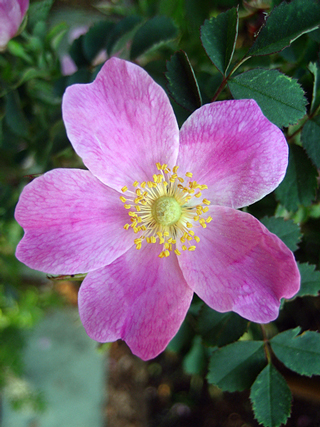 R. webbiana
R. webbiana
Photo: John Levett
Coincidentally, Lower Binfield came to me when I was talking with a group of students a few weeks back. The subject was ‘Spaces of Transit’ and I referred to John Schlesinger’s early documentary on Waterloo Station ‘Terminus,’ filmed in 1961. I then diverted to the performance and paraphernalia of travel in the early decades after the war and we continued on, discussing class indicators within the station hierarchy and mirrored in the passage of the station’s users. Fun stuff but it reminded me (if remembrance was needed) of the passage out of consciousness and awareness with each succeeding generation of a topology of social relationships.
The same thought came to me in my garden a couple of weeks back—the customs of rose growing from the rose book, to the nurseryman-rarely-a-woman’s catalogue, to the ground plan, to the personal visit to the rose fields, the wait until October until the bare roots were ready for collection along with bone meal and mulch. The ritual was part of the joy, the postponement of satisfaction part of the price. Antique but worth the entry fee to the Society of Well-Serious Rose Growers.
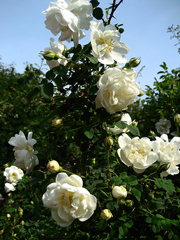 Burnet Double-white
Burnet Double-white
Photo: John Levett
My roses were just beginning to show and we came to be blessed with two weeks of continuous sunshine. Coincidentally a wind straight from the north European tundra came with it but such is the configuration of my garden that I can shift seats with the passage of the sun and the prevailing wind. I’d finished planting out last year’s sowing of delphinium (forty plants which’ll have to take their chances in between the established population), had only eight hollyhocks either from a dud packet or a dud sower, and cleared the decks for a long sit.
It comes as a surprise to anyone looking at my garden to hear that it was planned. The planning took two summers of visits to rose gardens in the east—the Roses Society’s gardens at St. Albans and Peter Beales’s nurseries in Norfolk in particular and a bunch of scattered gardens in Suffolk and Essex. I finished with a list of one hundred and twenty roses that I wanted in a garden. Unfortunately, not the garden I’ve got. I settled for fifty six; still too many but even if I got one flower in one season only I could genuinely say that I’d grown (if not cultivated) it.
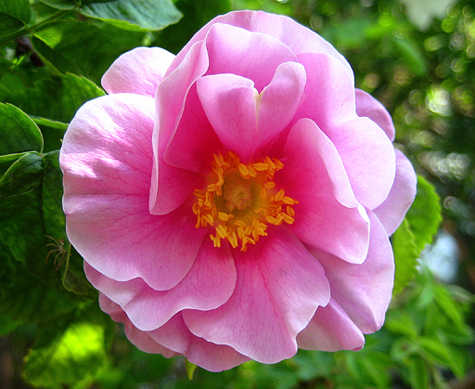
R. virginiana plena—now ten feet tall, a bower maker
Photo: John Levett
The garden is dominated by what I loosely call ‘species’ roses though, strictly speaking, some are not ‘species’ at all. Thus R. virginiana is a species but R. dunwichensis isn’t. The question ‘Why?’ has never bothered me much and the answer is a long one; the only concern for me was that they were singles, came early in the season and were such that I could take them as integral to the history of the rose. History was everything in the planning—history of the rose and history of me.
From the year that Stan Smith won Wimbledon to the year Boris Becker did I entered the Hitchin Horticultural Society’s Annual Show. (Note: I’m no tennis fan but Hitchin always held its show on the last weekend of Wimbledon. 1985 was also the last year that I waved a cricket bat close enough to a first ball to register nought). I swept the board every year with my delphiniums but in only one did I take the Hitchin Cup for roses. I put it down to timing. The Hitchin Show came early in the season and was always held at Jack Harkness’s rose nursery so it attracted attention of rose pros from the furthest reaches of the kingdom trying to suss out the competition for the national shows later in the Summer. However, once was enough, and my name’s still on the cup wherever it is now.
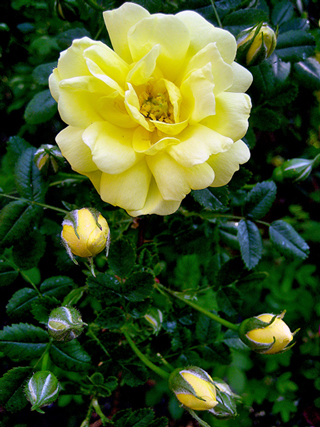 ‘Old Yellow Scotch” – descendant R. pimpinellifolia
‘Old Yellow Scotch” – descendant R. pimpinellifolia
Photo: John Levett
When I came to plan the current plot I wasn’t going in for the big bloomers any more. What I was after was anything the Rev. Joseph H. Pemberton would have brushed past in his vicarage. For me it has always been the early singles that keep me related and then the doubles to which they relate. Thus, R. pimpinellifolia (the Scotch briar or burnet) featured much in cottage gardens of the last century and, while not especially distinguished itself, was disease-free, no trouble to grow and gave its health to such as ‘Altaica,’ ‘Scotch Double White,’ ‘Old Yellow Scotch’ and ‘Single Cherry.’
R. sericea has given me ‘Hidcote Gold’ and ‘Red Wing’ with its red wedges of thorns. ‘Hidcote Gold’ hasn’t flowered this year; it’s giving out a lot of foliage so maybe next year if I hold back on the pruning.
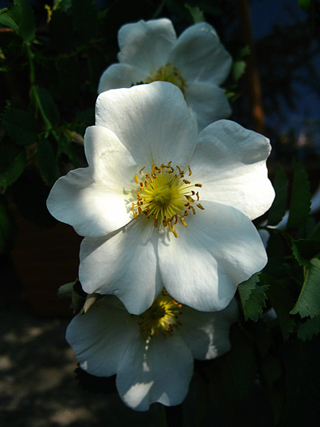 R. altaica—another descendant of the Scotch briar
R. altaica—another descendant of the Scotch briar
Photo: John Levett
R. xanthina gives me ‘Canary Bird’ usually the first in flower but about two weeks later this year. The foliage, like many of these hybrids, is fern-like and the wood dark. It’s these characteristics of the species and their hybrids that seals things for me to sit in the garden before flowering time and love the greens and browns for themselves.
R. ecae produced ‘Golden Chersonese’. R. ecae was first brought from Afghanistan in the 1880s but has few hybrids, which are a rich yellow and flower abundantly. Another of its hybrids is ‘Helen Knight,’ which I have never seen.
‘Cantabrigiensis’ (pictured at top) comes from R. hugonis. It’s a pale primrose-yellow and was raised at the Cambridge Botanic Garden in 1931. This is its best year ever. It is impossible to predict how these singles will flower. My garden is north facing and this collection is planted against a south facing fence so they get the morning sun rising above the warehouse roof and retain it until it passes behind next door’s back fence around noon.
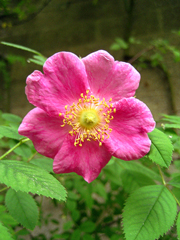 ‘Doncasterii’—blooming in the shade
‘Doncasterii’—blooming in the shade
Photo: John Levett
‘Doncasterii’ was a misplanting but amazingly flourishes. It’s planted below the warehouse wall, was early overshadowed by the drapery of ‘Bobbie James’ and ‘Félicité et Perpétue,’ but it flowers well in the shade.
R. davidii is, I believe, a true species. Many growers give it as a mid-June flowerer but mine always comes in early May. Its top shoots just catch a nip of the sun but it remains vigorous and gives the best heps of any of my roses in the Autumn.
The best of the bunch this year has been the ‘Dunwich Rose’ (sometimes R. dunwichensis). It was discovered on sand dunes at Dunwich on the east coast. Its low growing and would make a manageable hedge.
 R. dunwichensis
R. dunwichensis
Photo: John Levett
The pruning of these singles is crucial to the flowering. In larger gardens these that I have would be given their head and be allowed to throw up new wood with a cutting back maybe every five or six years. I don’t have the luxury of space for that so I need to prune yearly; I get it right half-and-half.
One that I do let have its head is R.virginiana plena which is a double pink. The plant is over ten feet tall now but the flower-heavy branches flop into a bower.
The last to bloom in April was R. persetosa which Jack Harkness, in his 1978 ‘Roses’, describes as a variety or hybrid of R. macrophylla; it’s rarely mentioned in the main authorities. The stems are populated with minute thorns, the pink flowers are no larger than a nail head and the Autumn heps the size of a pen nib.
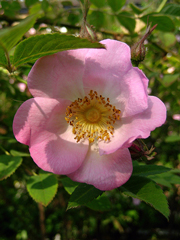 R. davidii, a true species rose
R. davidii, a true species rose
Photo: John Levett
I vaguely remember a diary entry of Orwell cycling into Hitchin from his cottage in Wallington and buying roses (Albertines?) in Woolworth’s (or was it in Brooker’s?) Coming from his grocer’s shop he would likely have passed through Letchworth and then past Jack Harkness’s nursery on the hill down into town. Why not stop? Too pricey for him or too lower-upper-middle class to his mind; or was he simply a Woolworth’s man?
(Later this same day: having taken lunch of grilled cheese on toast and nuclear-strength tea I see that ‘Hidcote Gold’ has a bud. About time too!)
Comments
Never seriously contemplated a rose garden until this essay. Wishing for land…


You have undertaken a wonderful project, and am amazed at the wealth of information you have collected. I will be visiting this site frequently to read and enjoy your posts.
I am from Bangalore , the garden city of India , and am a lover of nature. I do a bit of gardening and grow a few flowers, fruits and vegetables.
As you must be aware , Indian culture is abound with stories and mythology which narrates the intimate links we Indians have with flowers , trees….the local flora and fauna. We use leaves , grass and flowers for worshiping , in decorative art like floor patterns ( Rangoli), in temples sculptures in very stylized form and of-course as garlands to adorn our hair and body.
Ayurveda , our ancient system of health and well being uses many flowers and leaves in its preparation of medicines and tonics to rejuvenate the body and soul.
I hope I will be able to contribute , a small write up with photos , to this site about our love for flowers …and nature in general
Regards
Malathi